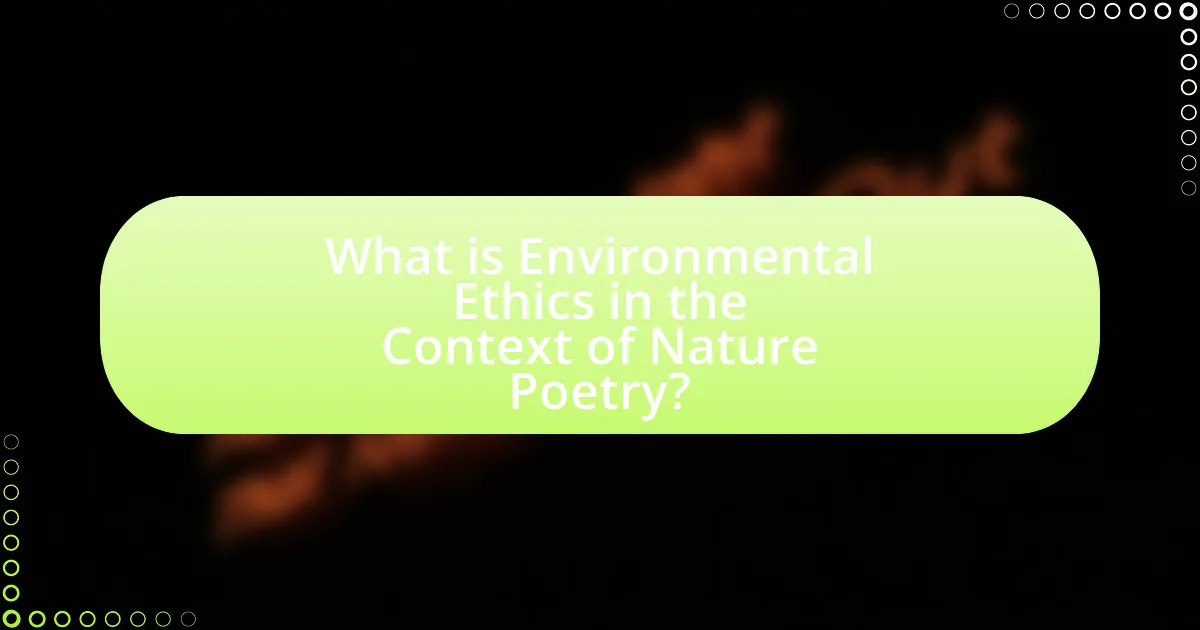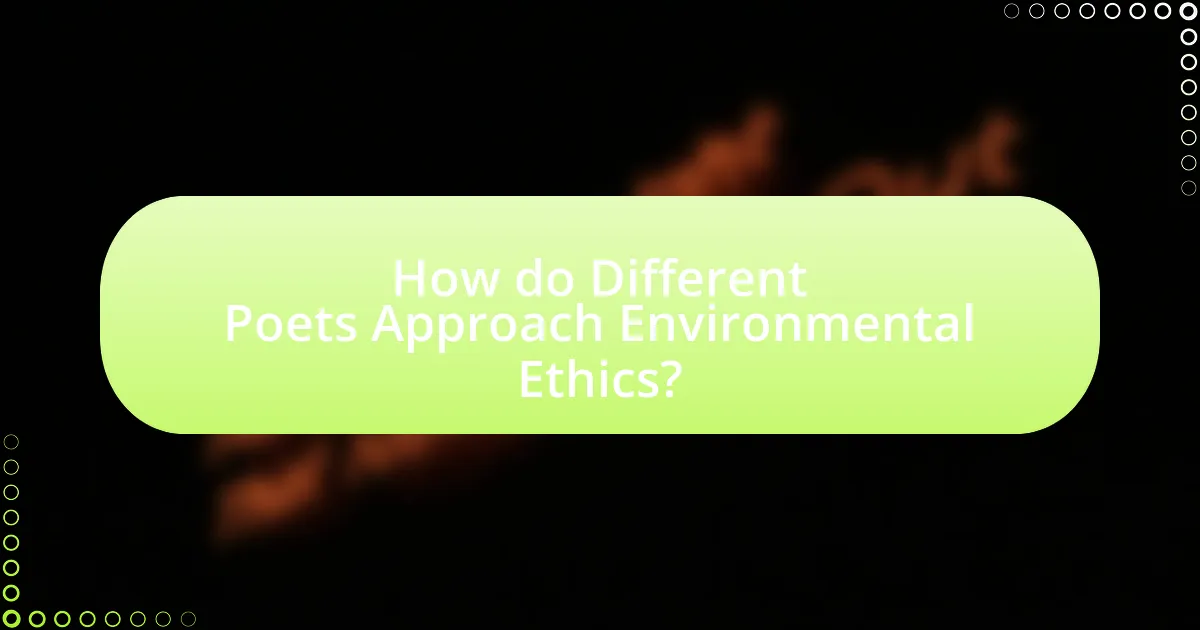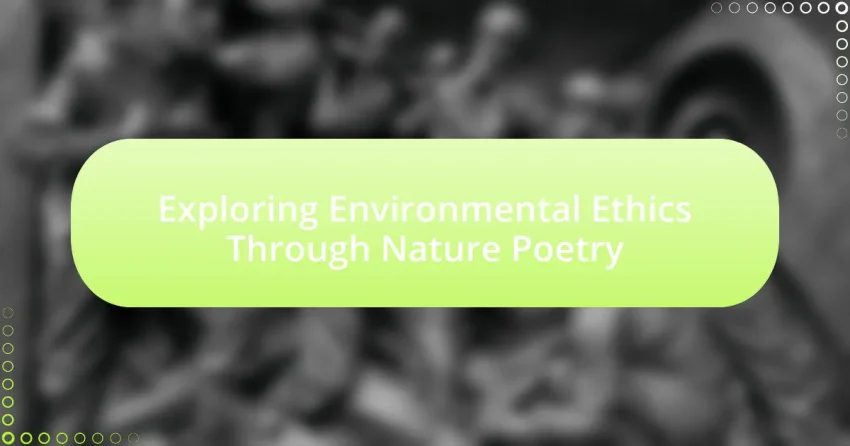The article “Exploring Environmental Ethics Through Nature Poetry” examines the moral relationship between humans and the natural world as expressed in nature poetry. It highlights how poets like John Keats and Mary Oliver reflect environmental ethical concerns by emphasizing the intrinsic value of nature and advocating for its preservation. Key themes such as interconnectedness, human impact on the environment, and the use of imagery to convey ethical messages are discussed, along with the importance of environmental ethics in contemporary society. The article also explores how literature, particularly poetry, shapes public perception of environmental issues and inspires action towards conservation, while addressing the challenges faced by nature poets in promoting environmental ethics.

What is Environmental Ethics in the Context of Nature Poetry?
Environmental ethics in the context of nature poetry refers to the moral relationship between humans and the natural world as expressed through poetic forms. Nature poetry often reflects on the intrinsic value of nature, advocating for its preservation and respect, which aligns with environmental ethical principles that emphasize the importance of ecological balance and sustainability. For instance, poets like John Keats and Mary Oliver illustrate the beauty and interconnectedness of life, prompting readers to consider their responsibilities toward the environment. This connection between poetry and environmental ethics fosters a deeper understanding of ecological issues and encourages a more compassionate approach to nature.
How does nature poetry reflect environmental ethical concerns?
Nature poetry reflects environmental ethical concerns by emphasizing the intrinsic value of nature and advocating for its preservation. Poets often depict the beauty and interconnectedness of ecosystems, highlighting the moral responsibility humans have to protect the environment. For instance, works by poets like John Keats and Mary Oliver illustrate the emotional and spiritual connections between humans and nature, urging readers to consider the consequences of environmental degradation. This literary form serves as a vehicle for raising awareness about ecological issues, promoting sustainability, and inspiring action against climate change, thereby reinforcing the ethical imperative to respect and care for the natural world.
What themes in nature poetry highlight environmental ethics?
Themes in nature poetry that highlight environmental ethics include interconnectedness, the intrinsic value of nature, and the critique of human impact on the environment. Interconnectedness emphasizes the relationship between humans and the natural world, illustrating how actions affect ecosystems. The intrinsic value theme argues that nature deserves respect and protection regardless of its utility to humans, as seen in works by poets like John Muir. Additionally, critiques of human impact, such as pollution and deforestation, are prevalent in the poetry of writers like Mary Oliver, who often reflect on the consequences of neglecting the environment. These themes collectively advocate for a more ethical and sustainable relationship with nature.
How do poets use imagery to convey ethical messages about nature?
Poets use imagery to convey ethical messages about nature by creating vivid and sensory representations that evoke emotional responses and highlight the interconnectedness of humans and the natural world. For instance, through detailed descriptions of landscapes, flora, and fauna, poets illustrate the beauty and fragility of ecosystems, prompting readers to reflect on their responsibilities toward environmental preservation. An example is Mary Oliver’s poem “The Summer Day,” where she uses imagery of a grasshopper to emphasize the wonder of life and the urgency of living mindfully within nature. This approach not only enhances the aesthetic experience but also serves as a moral call to action, urging individuals to recognize their role in protecting the environment.
Why is environmental ethics important in contemporary society?
Environmental ethics is important in contemporary society because it guides human interactions with the natural environment, promoting sustainability and responsible stewardship. This ethical framework helps address pressing issues such as climate change, biodiversity loss, and pollution, which threaten ecological balance and human well-being. For instance, the Intergovernmental Panel on Climate Change (IPCC) reports that human activities have caused approximately 1.1 degrees Celsius of global warming since the pre-industrial era, underscoring the urgent need for ethical considerations in environmental decision-making. By fostering a sense of responsibility towards nature, environmental ethics encourages individuals and communities to adopt practices that protect ecosystems and ensure a sustainable future for generations to come.
What role does literature play in shaping public perception of environmental issues?
Literature plays a crucial role in shaping public perception of environmental issues by providing narratives that evoke emotional responses and foster awareness. Through storytelling, poetry, and essays, literature can highlight the beauty of nature, the consequences of environmental degradation, and the moral imperatives for conservation. For instance, works like Rachel Carson’s “Silent Spring” have historically raised awareness about pesticide use and its ecological impacts, leading to significant policy changes and a heightened public consciousness regarding environmental protection. Such literary contributions not only inform but also inspire action, making them vital in the discourse surrounding environmental ethics.
How can nature poetry inspire action towards environmental conservation?
Nature poetry can inspire action towards environmental conservation by evoking emotional connections to the natural world, prompting readers to reflect on their relationship with the environment. This genre often highlights the beauty and fragility of ecosystems, encouraging individuals to recognize the urgency of conservation efforts. For instance, the works of poets like Mary Oliver and John Keats illustrate the profound impact of nature, which can lead to increased awareness and advocacy for environmental protection. Studies have shown that literature, including poetry, can influence attitudes and behaviors regarding environmental issues, as it fosters empathy and a sense of responsibility towards nature.

How do Different Poets Approach Environmental Ethics?
Different poets approach environmental ethics by reflecting on the relationship between humanity and nature, often emphasizing interconnectedness and the moral responsibility to protect the environment. For instance, poets like Mary Oliver celebrate the beauty of the natural world and advocate for a deep appreciation of nature, which fosters ethical stewardship. In contrast, poets such as Gary Snyder incorporate ecological principles and indigenous philosophies, urging readers to recognize the intrinsic value of all living beings and the importance of sustainable living. This diverse range of perspectives illustrates how poetry can serve as a powerful medium for exploring and promoting environmental ethics, encouraging readers to engage with ecological issues on a personal and societal level.
What are the distinct styles of poets who focus on nature and ethics?
Distinct styles of poets who focus on nature and ethics include Romanticism, Transcendentalism, and Ecopoetry. Romantic poets, such as William Wordsworth, emphasize emotional responses to nature, often portraying it as a source of inspiration and moral guidance. Transcendentalist poets, like Ralph Waldo Emerson, advocate for the inherent goodness of nature and the importance of individual intuition in understanding ethical relationships with the environment. Ecopoetry, represented by contemporary poets such as Gary Snyder, integrates ecological awareness with poetic form, often addressing environmental issues and advocating for sustainability. These styles collectively highlight the interconnectedness of nature and ethical considerations, reflecting a deep engagement with environmental themes.
How do romantic poets express their views on nature and ethics?
Romantic poets express their views on nature and ethics by portraying nature as a source of inspiration and moral guidance. They often depict the natural world as a reflection of human emotions and ethical values, emphasizing the interconnectedness between humanity and the environment. For instance, William Wordsworth’s poetry frequently illustrates the idea that nature possesses an inherent moral quality, suggesting that a deep appreciation for nature can lead to ethical living. In “Lines Composed a Few Miles Above Tintern Abbey,” Wordsworth articulates how nature nurtures the human spirit and fosters a sense of responsibility towards the environment. Similarly, John Keats emphasizes the beauty of nature in his works, arguing that an ethical life is one that recognizes and cherishes the natural world. This connection between nature and ethics in Romantic poetry underscores the belief that understanding and respecting nature is essential for moral development.
What modern poets are influential in the environmental ethics discourse?
Modern poets influential in the environmental ethics discourse include Mary Oliver, Gary Snyder, and Wendell Berry. Mary Oliver’s poetry often emphasizes the beauty of nature and the importance of connecting with the natural world, as seen in her collection “American Primitive,” which won the Pulitzer Prize. Gary Snyder, known for his deep ecological perspective, integrates themes of nature and spirituality in works like “Turtle Island,” which won the Pulitzer Prize for Poetry in 1975. Wendell Berry advocates for sustainable agriculture and environmental stewardship in his poetry and essays, particularly in “The Peace of Wild Things.” These poets contribute significantly to the discourse by highlighting the relationship between humanity and the environment, urging readers to consider ethical implications of their actions toward nature.
How do cultural perspectives influence poetic expressions of environmental ethics?
Cultural perspectives significantly influence poetic expressions of environmental ethics by shaping the themes, imagery, and values reflected in the poetry. For instance, Indigenous cultures often emphasize a deep connection to nature, viewing the environment as a living entity deserving respect, which is evident in their poetry that highlights stewardship and reciprocity with the land. In contrast, Western perspectives may focus on nature as a resource for human benefit, leading to poetry that critiques environmental degradation and advocates for conservation. This divergence is supported by the work of poets like Mary Oliver, who draws on personal experiences with nature, and Gary Snyder, who incorporates Eastern philosophies into his environmental themes. Such variations illustrate how cultural backgrounds inform the ethical considerations poets express regarding the environment.
What are examples of indigenous poetry that address environmental ethics?
Examples of indigenous poetry that address environmental ethics include works by poets such as Joy Harjo, who emphasizes the interconnectedness of nature and humanity in her poem “An American Sunrise.” Additionally, the poetry of Gary Snyder often reflects on the relationship between indigenous cultures and the natural world, as seen in his collection “Turtle Island,” which advocates for ecological awareness and respect for the environment. These poets illustrate the importance of environmental stewardship and the ethical responsibilities humans have towards nature, reinforcing the idea that cultural identity is deeply tied to the land and its preservation.
How does cultural background shape a poet’s view on nature and ethics?
Cultural background significantly shapes a poet’s view on nature and ethics by influencing their values, beliefs, and experiences related to the environment. For instance, poets from indigenous cultures often express a deep connection to nature, reflecting a worldview that emphasizes harmony and respect for the land, as seen in the works of poets like Joy Harjo, who incorporates Native American perspectives on ecology. Conversely, poets from industrialized societies may critique environmental degradation, as demonstrated by the writings of poets like Gary Snyder, who addresses the ethical implications of modernity on nature. This divergence illustrates how cultural narratives and historical contexts inform a poet’s ethical stance and aesthetic representation of the natural world.

What Impact Does Nature Poetry Have on Environmental Awareness?
Nature poetry significantly enhances environmental awareness by fostering emotional connections to nature and highlighting ecological issues. Through vivid imagery and evocative language, nature poetry encourages readers to reflect on their relationship with the environment, often prompting a sense of responsibility toward conservation. For instance, poets like Mary Oliver and John Keats have used their works to illustrate the beauty and fragility of natural landscapes, which can inspire readers to engage in environmental activism. Studies have shown that literature, including poetry, can influence attitudes and behaviors regarding environmental conservation, as it often evokes empathy and a deeper understanding of ecological interdependence.
How can nature poetry serve as a tool for environmental education?
Nature poetry serves as a tool for environmental education by fostering emotional connections to the natural world, which can enhance awareness and inspire action. Through vivid imagery and evocative language, nature poetry illustrates the beauty and fragility of ecosystems, making complex environmental issues more relatable and accessible. For instance, poets like Mary Oliver and John Keats have effectively used their work to highlight the importance of biodiversity and the impact of human activity on nature. Research indicates that literature, including poetry, can significantly influence environmental attitudes and behaviors, as it encourages readers to reflect on their relationship with the environment and motivates them to engage in conservation efforts.
What are effective ways to incorporate nature poetry into environmental curricula?
Effective ways to incorporate nature poetry into environmental curricula include integrating poetry readings and discussions into lessons on ecology and conservation. This approach allows students to connect emotionally with environmental themes, fostering a deeper understanding of ecological issues. Research indicates that literature, including poetry, enhances critical thinking and empathy, which are essential for environmental stewardship. For instance, a study published in the Journal of Environmental Education found that students who engaged with nature poetry demonstrated increased awareness of environmental issues and a greater willingness to participate in conservation efforts. By using nature poetry as a tool for reflection and dialogue, educators can effectively enhance students’ engagement with environmental ethics.
How does poetry evoke emotional responses that lead to environmental action?
Poetry evokes emotional responses that lead to environmental action by using vivid imagery and personal narratives to connect readers with nature. This connection fosters empathy and a sense of urgency regarding environmental issues. For instance, studies show that emotionally charged language in poetry can increase awareness and motivate individuals to engage in conservation efforts. Research by environmental psychologists indicates that emotional engagement, often triggered by art forms like poetry, can significantly influence pro-environmental behaviors, as seen in campaigns that utilize poetic expressions to inspire community action.
What are the challenges faced by nature poets in addressing environmental issues?
Nature poets face several challenges in addressing environmental issues, primarily the difficulty of conveying complex scientific concepts in an accessible and engaging manner. This challenge arises because environmental issues often involve intricate details about ecosystems, climate change, and biodiversity that may not resonate with a general audience. Additionally, nature poets must navigate the emotional weight of environmental degradation, balancing their artistic expression with the urgency of advocacy. For instance, the poet may struggle to evoke a sense of urgency without resorting to despair, which can alienate readers. Furthermore, the competition for attention in a media-saturated environment makes it challenging for their messages to stand out. These factors collectively hinder the effectiveness of nature poetry in raising awareness and inspiring action on environmental issues.
How do societal attitudes towards nature affect the reception of nature poetry?
Societal attitudes towards nature significantly influence the reception of nature poetry by shaping readers’ emotional and intellectual responses to the themes presented. When society values environmental conservation and ecological awareness, nature poetry often resonates more deeply, as it aligns with contemporary concerns about climate change and biodiversity loss. For instance, during the Romantic period, poetry that celebrated nature was well-received because it reflected a growing appreciation for the natural world amidst industrialization. Conversely, in societies that prioritize urbanization and technological advancement over environmental issues, nature poetry may be dismissed or undervalued, as it conflicts with prevailing attitudes. This dynamic is evident in modern literary trends, where poets addressing environmental crises gain recognition, reflecting a shift in societal values towards sustainability and ecological responsibility.
What barriers exist in promoting environmental ethics through poetry?
Barriers in promoting environmental ethics through poetry include limited audience engagement, cultural perceptions, and the complexity of environmental issues. Limited audience engagement arises because poetry often appeals to a niche group, making it difficult to reach broader audiences who may not prioritize environmental concerns. Cultural perceptions can hinder the acceptance of environmental themes in poetry, as some cultures may not value artistic expressions that address ecological issues. Additionally, the complexity of environmental issues can make it challenging for poets to convey messages effectively, leading to misunderstandings or oversimplifications that fail to resonate with readers. These barriers collectively impede the potential impact of poetry as a medium for promoting environmental ethics.
What practical steps can readers take to engage with environmental ethics through poetry?
Readers can engage with environmental ethics through poetry by actively reading, writing, and sharing poems that reflect ecological themes. Engaging with poetry that addresses environmental issues fosters awareness and encourages critical thinking about human relationships with nature. For instance, readers can participate in workshops or community events focused on nature poetry, which often highlight the importance of conservation and sustainability. Additionally, writing their own poems about personal experiences in nature can deepen their understanding of environmental ethics. Sharing these poems in local or online platforms can further amplify the message and inspire others to reflect on their environmental responsibilities.
